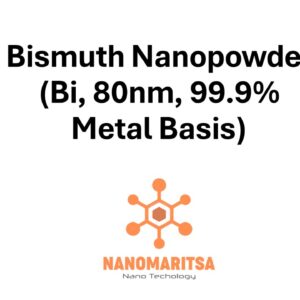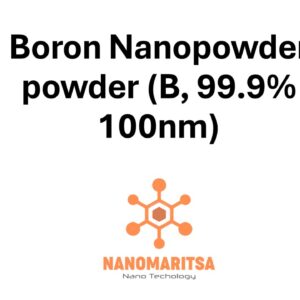Gold Nanopowder (Au, >99.95+%, 15 nm) is an advanced material composed of ultra-fine gold particles with an average diameter of 15 nanometers (nm). This nanopowder retains the exceptional properties of gold, including its high conductivity, chemical stability, and biocompatibility, while offering unique nanoscale attributes such as a high surface area and enhanced reactivity. Below is a detailed overview:
1. Key Features:
Gold (Au): Gold is a noble metal renowned for its excellent electrical conductivity, chemical inertness, and resistance to oxidation. These properties make gold nanopowder highly desirable in fields ranging from electronics to medical applications.
Purity (>99.95+%): With an ultra-high purity of greater than 99.95%, this gold nanopowder contains minimal impurities, ensuring superior performance in sensitive applications such as biomedical devices, catalysis, and high-precision electronics.
Nanoparticle Size (15 nm): The small particle size of 15 nm provides a significantly enhanced surface area-to-volume ratio. This feature enables improved chemical reactivity, efficient dispersion in solutions, and superior interaction with other materials compared to bulk gold or larger particles.
Metal Basis: The metal basis confirms that over 99.95% of the nanopowder is composed of pure gold, guaranteeing consistent and reliable material properties.
2. Properties:
High Surface Area: The nanoscale size of gold particles results in an increased surface area, making the material highly effective for applications that rely on surface interactions, such as catalysis and sensor technologies.
Exceptional Conductivity: Gold nanopowder retains the metal’s excellent electrical and thermal conductivity, making it ideal for applications requiring efficient energy transfer, such as in conductive inks, coatings, and microelectronics.
Chemical Stability: Gold’s inherent resistance to corrosion and oxidation is preserved in its nanopowder form, ensuring long-term stability in demanding environments, including those involving harsh chemicals or extreme conditions.
Biocompatibility: The biocompatible nature of gold nanopowder makes it a preferred choice in biomedical and pharmaceutical applications, including drug delivery systems and imaging agents.
Optical Properties: Gold nanoparticles exhibit unique optical properties, such as localized surface plasmon resonance (LSPR), which makes them valuable in applications like photothermal therapy, biosensing, and advanced imaging techniques.
3. Applications:
Biomedical Applications: Gold nanopowder is extensively used in drug delivery systems, cancer treatment via photothermal therapy, and as a contrast agent in imaging techniques such as CT scans and optical microscopy. Its biocompatibility and stability make it suitable for use in medical devices and implants.
Electronics and Conductive Materials: Due to its excellent conductivity, gold nanopowder is utilized in microelectronics, conductive inks, and coatings for high-precision components. Its nanoscale properties enable enhanced performance in flexible and wearable electronic devices.
Catalysis: The high surface area and reactivity of gold nanopowder make it an effective catalyst for chemical reactions, including selective oxidation, hydrogenation, and environmental pollutant removal.
Sensors: Gold nanoparticles are integral to the development of sensitive biosensors and chemical sensors, leveraging their optical and electronic properties for applications in diagnostics, environmental monitoring, and industrial process control.
Energy Applications: Gold nanopowder is used in advanced energy technologies, such as fuel cells and solar cells, where its conductivity and catalytic properties enhance efficiency and performance.
Optical Devices and Plasmonics: The unique interaction of gold nanoparticles with light enables their use in plasmonic devices, optical filters, and photodetectors, as well as in artistic and decorative applications requiring vibrant colors and stability.
4. Handling and Safety:
Health and Safety Considerations: Although gold nanopowder is generally considered non-toxic due to its chemical inertness, care must be taken to avoid inhalation or prolonged skin contact. Always wear appropriate personal protective equipment (PPE), such as gloves, safety goggles, and masks, during handling.
Storage: Gold nanopowder should be stored in a cool, dry environment in sealed containers to prevent contamination or aggregation of particles. Proper storage ensures the material’s long-term stability and usability.
Precautions: Handle gold nanopowder in a controlled environment to prevent airborne dispersion. Use proper disposal methods in compliance with local regulations to minimize environmental impact and ensure safety.
Summary:
Gold Nanopowder (Au, >99.95+%, 15 nm) represents a cutting-edge material that combines the intrinsic properties of gold with the unique advantages of nanoscale particles. Its high purity, exceptional conductivity, stability, and biocompatibility make it indispensable in diverse fields, including electronics, medicine, catalysis, and energy. Proper handling and storage are essential to fully leverage its capabilities while ensuring safety and environmental responsibility. This nanopowder is a cornerstone of advanced technology and innovation, enabling breakthroughs across multiple industries.
| Measurement (gr) | 1 gram, 5 grams, 25 grams |
|---|






